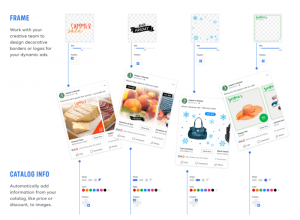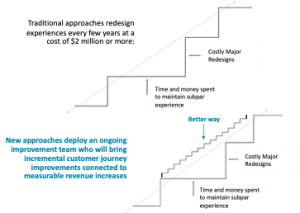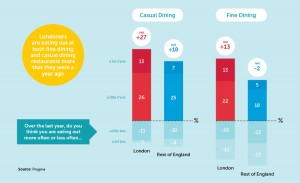Revenue Marketing Journey: Milepost 1
Revenue Marketing is the combined set of strategies, processes, people, technologies, content and results measurement across marketing and sales that does four things:
- drops sales-ready leads into the top of the funnel
- accelerates sales opportunities through the funnel
- measures marketing based on contribution to pipeline and revenue, and ultimately
- transforms marketing from a cost center to a revenue center
In a series of monthly posts, I will chronicle the major tasks fundamental to transforming your marketing organization to one that influences revenue in a predictable, scalable way.
The increasing importance of customer experience requires us to transform marketing.
Jerry Gregoire, chief information officer at Dell said: “The customer experience is the next competitive battleground.” Is the customer experience at your firm sufficient to motivate a marketing transformation? Consider these examples of customer experience driving change:
- Vinyl shifted to CDs, then to iPods and now to Spotify, Pandora and Songza. The product is the same, music, but the customer experience is much different and driving the change.
- Blockbuster and Hollywood Video are replaced by Netflix, iTunes, HBO Now, and Amazon Prime. Same product, different customer experience.
- Are you hailing a yellow cab, or scheduling an Uber or Lyft? I’ll wager you have tried the latter two and had a different experience.
- Have your tried using an Amazon Dash button at home to order laundry detergent?
- Have you pre-ordered and prepaid for your Starbucks beverage so you can breeze in, skip the line and be sipping in seconds?
- And how about those iPads at every table in some airport restaurants replacing the wait staff? The food is the same (sadly), but the customer experience is certainly different.
The internet has changed the way people buy and how they want to engage with us. The buyer’s journey has changed and if we adapt marketing faster than our competitors we can gain market share. But responding to pressures from prospects isn’t the only impetus to transform marketing.
Sales wants effective marketing engagement with their funnel.
There are various conflicting statistics about how much of the buying journey is over before the buyer wants to engage with sales, most of them suggesting in excess of 50%. One thing is for sure, buyers are increasingly engaging with us through marketing’s digital channels when they are in the awareness, research, consideration and evaluation buying stages. These channels, include Facebook, Twitter, LinkedIn, YouTube, Google and your website. Sales knows that they can benefit from knowing exactly how and when a prospect engaged. What content did they view? What ad did they respond to? Furthermore, if a prospect is not ready for sales engagement the reps want to be able to advise marketing how to nurture that individual. Perhaps they want marketing to engage with several large strategic accounts and help the sales reps penetrate deeper and broader (Account Based Marketing). Not a new concept, but we now have technologies and marketing channels that make these activities much more measurable and more cost effective.
Marketing teams want to know their efforts make a difference.
Marketers know that the buyer behavior is shifting. They know there are new channels and new marketing technologies to help them. Marketers want to transform from lead generation and demand generation to a modern marketing approach to engaging prospects and customers. They know that more CEOs are insisting that marketing demonstrate a strong ROI. Most marketing management I meet understand that the old marketing structures with their silos will not work in a world where prospects interact through several channels for a single business transaction.
First steps on the journey
The destination is a revenue marketing organization that delivers repeatable, predictable, scalable results that generate a significant impact on the pipeline and revenue. Key milestones along the way include:
- Choosing the channels with which to engage prospects and customers
- Deploying a revenue marketing architecture that will scale
- Adopting the best processes, especially around lead management and program development
- Choosing and enforcing the right KPIs
- Overhauling the content factory and becoming customer centric, not product centric.
- Organizing for success
In the next post, we will discuss organizing for success in revenue marketing and designing a marketing center of excellence. For more insights, download TPG’s new white paper: Introduction to the Revenue Marketing Center of Excellence.
As posted previously in Target Marketing Magazine on September 26, 2016
Business & Finance Articles on Business 2 Community(48)







